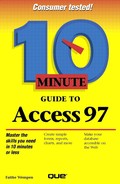Parts of the Screen
Access is much like any other Windows program: it contains menus, toolbars, a status bar, and so on. Figure 3.2 points out these landmarks. Notice that in Figure 3.2, many of the toolbar buttons are grayed out (which means you can't use them right now). There's also nothing in the work area. That's because no database file is open. The Access screen will become a much busier place in later lessons when we begin working with a database. The buttons will become available, and your database will appear in the work area.
Figure 3.2. Access has the same interface landmarks as any Windows program.

Understanding Access Toolbars
If you have used Windows programs before, you are probably familiar with toolbars. They're rows of buttons that represent common commands you can issue. Toolbar buttons are often shortcuts for menu commands.
The toolbar changes depending on which object you're working with at the time (Table, Form, and so on), and what you're doing to it. More toolbars sometimes appear when you're doing special activities, such as drawing. To find out what a toolbar button does, point at it with your mouse pointer. Its name appears next to the pointer (see Figure 3.3). This feature is a ToolTip (or a ScreenTip); you can use ToolTips even when a button is unavailable (grayed out).
Figure 3.3. To find out what a toolbar button does, point at it.

Customizing Toolbars
You can choose which toolbars you view at any time, and even add and remove buttons from a toolbar. Right-click any toolbar and a shortcut menu appears. You can select a toolbar for viewing from that list, or click Customize to open a dialog box where you can customize any toolbar.
